|

< Back to Career archive
1980-1983: Capital Sound
In 1979 I switched to the “news shift”, doing the evening and late news bulletins at GTV so as to leave me time free during the day to start “Capital Sound”, a voice-over business based in the Richmond lighting business premises of friend and ex GTV Lighting Department colleague Brett Randall. I began to install a voice-over studio in an old paint store in one corner of the Lighting Corporation premises. As part of this push to become independent of television to keep my wife happy, it was decided she had to go out to work as well. Imagine my surprise when she announced she had a job - at Crawford Productions! So my working day settled down to rising at 5.00 a.m. to help get the kids ready – dropping the kids of at crèche, dropping my wife off at Crawford’s in Abbotsford at 9.00 a.m., driving to Richmond and working on the studio until midday, driving the car back to Crawford’s at lunchtime and walking to GTV to start my “real’ job, and then walking to Burnley after the late news to catch the last train home to arrive dog-tired at about 1.00 am. Four hours later the whole cycle would start over again.
I managed (just) to get through the year and handed my resignation in to Col Stevenson at the end of the closing credits of “Carols by Candlelight” on Christmas Eve 1979.
January 1980 saw me working part-time for Lighting Corporation and the rest of the time concentrating on Capital Sound. It was around this time that Brett Randall and I decided that when smoking dope we never seemed to get any work done, and I gave up smoking all together. Despite the fact that this aspect of my past life was relatively easy to discard, I never could quite get television out of my blood (and it always seemed that there was plenty of my blood in television!). It was here that Murray Tregonning re-entered the picture. By this time Murray had been freelance for a couple of years and was running his own business “Pamit Services”. We embarked on a number of ventures together. The first of these was the sound for the SBS soccer telecasts. The vision was being produced out of AAV Australia’s OB van, but the audio facilities were not quite up to what was required. The answer we came up with was to make some of the equipment in my voice-over studio demountable and I made up a rack to fit into my little yellow Mazda “Bongo” van. With some carpet and blackout curtains we had a mini-OB van. We also made the sound effects for the broadcasts a priority. Col Stevenson had pioneered the World Series Cricket stump mics for the Nine Network and, following his example, Murray and I perfected a system for ringing the soccer pitch with shotgun microphones so that we could follow the action on field, (and even change its perspective with a mic on the on-field camera for the close-ups). ATV10 later copied this for their FIFA World Cup matches and a similar system is still in use today for the on-field effects on AFL matches. We also experimented with radio mics on the referee, bringing the television audience right onto the field. Murray later went on to perfect this with his “Matchcom” system now used internationally on Rugby matches and on AFL telecasts. (See www.murraytregonning.com.au)
In the lead-up to my move to establish Capital Sound, Murray Tregonning, Brett Randall and I had dusted-off the Entertainment Services & Promotions brand and purchased the first rental prompter systems available in Australia. These used a small video camera to read scripts typed on adding-machine rolls. We also purchased some studio sound booms for hire, an old Mole-Richardson (arm only) we purchased from a film studio in Sydney where it had been used on “The Sundowners” and “On the Beach”, and also a second-hand Fisher boom that had been purchased for the Australian Film and Television School (but where no-one had bothered to persevere with its use because there were plenty of more glamorous jobs to be done). The trip to Sydney to collect these items turned into quite a saga. Murray and I had both done “Hey Hey” that morning, so by the time we had come off air and packed-up the control room we had already been working for some time. We piled into the Bongo van and set-off for Sydney at its top speed of 80km/hr (downhill and with a tail wind). We had arranged for somewhere in Sydney to stay but had warned our hosts that we might arrive quite late. It was well after midnight when we arrived in Sydney and finally found the address. The house (and those adjacent) were dark. After walking up the drive and bumbling around in the pitch blackness trying to find the back door, lights started to come on in neighbouring houses and dogs started to bark, so we beat a hasty retreat. A street or two away a check in the street directory confirmed we had exactly the right address – but the wrong suburb! An hour later, dog-tired, we finally found the right house. Next morning, after only a few hours sleep, we had picked up both booms.
The Mole arm, wrapped in canvas, was strapped on the roof-rack along with the Fisher arm in its wooden packing crate, with the Fisher pram in its packing case jammed in the back of the van. About lunchtime, we set-off back for Melbourne. By this time we were so tired we were taking short turns at driving whilst the other cat-napped on top of the pram crate in the back of the van. It was the early hours of Monday morning by the time we got back to Melbourne. A scant few hours later, Murray received a phone call from GTV to say that they had wrecked their boom transferring it between the two “Sullivans” studios and could we get our new boom there as soon as possible! The Fisher got by far and away the bulk of the hires over the next few years, including a long stint at ATV10 on “Prisoner”.
However, for bigger productions the complete Mole Richardson boom we purchased from GTV9 and restored was more versatile. Its first big outing was for the recording of a drama in AAV’s Studio “D” destined to go to air on the first ever night of transmission on SBS. It was a Greek play called something like “The Three Sea Wolves” in which the only words of English uttered were “Southerna Crossa Droycleeeners” when one of the characters answered a telephone call. This was my first ever boom job in a foreign language. How hard could this be I asked myself? Surely all I had to do was to follow the number of words in each line? Wrong. The script was typed on a Greek typewriter and was indecipherable to me. Ah, I know, I will take my throw cues from the inflections at the end of sentences! Wrong. You can’t hear inflections in a foreign language. In the end I had to trust to memory of the sounds and a desperate glance around to whoever was looking like they might talk next! I think that was definitely my most challenging boom job ever.
During this period I was also doing boom on “Cop Shop” and “Skyways”, which were both shot in the old Cambridge Films studios in South Melbourne. The problem was that HSV7 strung their booms backwards to the rest of the entire world. Instead of squeezing the handle to tilt the mic upwards, squeezing the handle at HSV tilted it downwards. This is akin to trying to drive a car where the brake and accelerator have been reversed. My solution was to bring my own Mole-Richardson boom arm to the studio and mount it on HSV’s pram. It worked fine for me but, of course, it was useless for the HSV boom operators, so I resigned myself to doing every scene on those days when I was working there.
Murray and I purchased quite a few radio mics back in the days when it was rare to have more than one radio mic on a production. Most of these were “Microns”, best-suited to field production as the receiver was battery-powered and had the innovative feature of a light system on the receiver so the battery state of the transmitter could be interrogated. Standard these days, but a real novelty in the early 1980s. Our first big multi-radio mic production was a recording for SBS of a classical Greek play performed in an amphitheatre down by the Yarra River in Fairfield. By this time the Bongo van had been set aside for a larger Toyota truck with a purpose-built body, and we hired GTV9’s 24-track Ampex recorder and somehow managed to get it into the back. Unfortunately, the truck was big and white so to hide it from the cameras in the only place we could park, it had to be partly covered in black cloth. Murray and I assembled eight Microns, quite a task when radio system frequencies were not agile and whatever frequency you purchased you were stuck with. Murray had developed a system of using large batteries to replace the small battery packs in the Microns, and each individual radio mic went straight to 24-track along with the effects and audience mics so that, using my mixed track as a guide, SBS could assemble the soundtrack in “post” to become the first-ever Australian recorded drama soundtrack to go to air in stereo on SBS.
This production was also notable for Murray surprising a well-known and formally betrothed male television personality of the day in the dressing room of the very voluptuous female star of the play!
As well as this sort of work Murray, the trusty Capital Sound truck and I worked on innumerable other productions. A favourite ploy of the Don Lane Show was to throw to various locations for quick crosses – two I particularly remember were a tour of the first electronic colour screen at the MCG and the last night of a well known 1950s rock club in the northern suburbs. We also covered a Military Tattoo at the MCG which went to air on the BBC. A lot of thought went into the microphone design for this with a range of shotgun mic types rigged on the same stands with all their capsules physically aligned. This meant that all the sound sources were exactly time coincident, and I was quite proud of the result. I also covered races in Geelong for ATV10 and at last learnt the secret of their close-miked hoof beat sound effects which I had always puzzled over. Did they have a mic and transmitter on the ambulance? No, they were cheating – there was a looped cartridge of horses hooves played underneath the real crowd sound effects. Very effective!
Apart from television OB work, Capital Sound undertook voice-overs and radio commercials, film sound recording, post-production for corporate videos, and some live sound reinforcement. It was at Capital Sound that I had my introduction to corporate theatre which, in the later years of my career, would become my livelihood. Probably the most memorable of these shows would be touring the sound for the Ford Meteor launch produced by Cameron Vernon Weston & Associates (I had worked with John Weston in the lighting department at GTV9). The show was a black-tie affair and technically innovative. After the appropriate speeches, a 70mm widescreen film was shown extolling the virtues of the Ford Meteor. At the end of the film, the two “hero” cars rose out of the sides of the stage on hydraulic hoists which then rotated. The MC then directed the audience to the rear of the room which was a wall of black drapes, and welcomed “Tommy Tycho and the Meteor Orchestra”. The drapes opened to reveal the band. Now, having worked with similar instrumentation at GTV, I was in my element at the audio console - Piano, guitar, drums, bass, three trumpets, three trombones and five reeds make a great band. The band played all the big hits of the swing era (mostly Glen Miller) with vocal duties undertaken by Dennis Walter and Jackie Love. We took the show to Melbourne, Sydney, Adelaide, Perth and Brisbane. In Adelaide we did a launch to the motoring press where the cast and crew outnumbered the journalists two to one! Perth was Jackie Love’s home town, and her mother would be in the audience. That night I sat Jackie’s vocal very slightly on top of Dennis’s vocal in the duets, and was told by Jackie’s mum that it was the best mix she had ever heard! We finished the show in a Greek Club in Brisbane. The gig was bumped-out straight after the show and, once the trucks were loaded, we went straight to a wrap party at a local restaurant. Everyone was dog-tired, we were a bit “sick of each other” after a month on the road, and a few became quite tired and emotional. Others were face down in their meals from sheer exhaustion. Then it was off to empty our motel rooms and straight to the plane home to Melbourne. Twenty bleary-eyed people who had been awake for more than twenty-four hours and just feeling the onset of hangovers trooped onto the plane. All went well until a whole plane load of passengers ripped open their bags of scrambled eggs. I was sitting next to Brett Randall and we were soon thinking of reaching for another type of bag commonly carried on aeroplanes.
There were also other sound reinforcement jobs which promised to be more mundane, but turned out to be less so. One such job was the ALP Federal Conference in Canberra which immediately preceded the election of the Hawke Labour Government. I was to look after the sound (both in the room and a mix for the media) whilst colleague Elena Erremin was to look after the lighting. All went pretty well technically, but it was the “two mines policy” debate that was to be the highlight. Labour had previously had a “no uranium mines” policy but it was apparent that, to win government, they would have to be more pragmatic and approve the two uranium mines then in operation. The tension in the room was palpable. During breaks in the debate there was open emotion displayed – opponents of uranium mines were in tears in the foyer. Both Elena and I were on the edges of our seats for the whole afternoon and during the actual vote you could have cut the air with a knife. It was a truly amazing experience but, of course, there is always the drudgery to follow – the load out and the long drive back to Melbourne. I can remember stopping the truck just north of Albury about 4.00 a.m. so Elena and I could run around it in the cold night air to wake ourselves up.
At one point Lighting Corporation inherited a container-load of equipment from Michael Edgely which had come back from a Circus in Japan where the tent had blown down in a typhoon before it could be bumped-out. It became my job to go through the audio equipment to see what could be salvaged for future Edgely tours. Soon I found myself on the road again with Dance Theatre of Harlem. This again was a national tour, and my job was to oversee the installation in each new theatre, tune the sound system, stay for opening night, and then leave Max Shayler to operate the season. The program included a first half of modern dance to backing tapes and a second half of classical ballet to a live orchestra with some subtle sound re-inforcement. I had worked on ballet before - Don Q at the Palais with Sir Robert Helpman, Rudolph Nureyev and Dame Margot Fonteyn. (Nureyev somehow knew when a follow spot operator had clipped his toes on a leap and, if it happened at rehearsal, he would stop and glare up at the hapless operator in the dome. The follow spots at the Palais were Brenkert’s, huge brass hand-fed carbon-arc spots with a woven asbestos blanket over one side and a small smoked-glass window for the operator to peer into the arc. The operator not only had to operate the spot to tight cues, but also to maintain his arc at constant brightness by screwing the carbon rod forward). However, Dance Theatre of Harlem was the first time that I had worked on leading-edge modern ballet, and I was fascinated. The US lighting designer had done a fabulous job, with simple sets and large blocks of colour. Since I didn’t have much to do during the first half of the show, I could just watch enthralled.
Unfortunately, this would soon come to an end. Any marriage where both parties work in the entertainment industry is going to be difficult to maintain, and mine was unfortunately no exception. With myself and my wife separated and with two households and a business to maintain in the economically difficult early 1980s, I could not earn enough profit from Capital Sound to outweigh the outgoings in leases for expensive equipment and vehicles. It was time to quit while I was still ahead, and the return of variety to GTV was my cue to move back into television full-time.
Next page >
|
 |
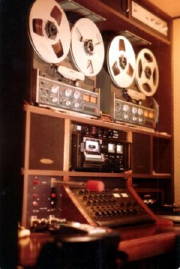
The first Capital Sound voice-over studio was constructed in an old concrete paint store
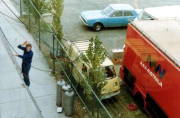
Rigging a soccer broadcast for SBS at South Melbourne. Murray Tregonning on the ladder with the Capital Sound yellow Bongo van parked next to the AAV vision truck
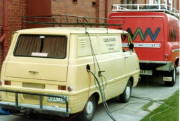
With AAV again, this time shooting a program on schools in Ballarat
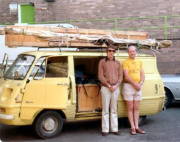
Picking up the Mole Richardson arm at Palm Studios in Sydney

Film, Television & Radio Sound Specialists...
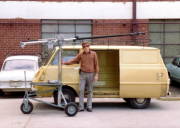
ESP’s first JL Fisher 2/3 boom at Crawford’s for use on “The Sullivans”
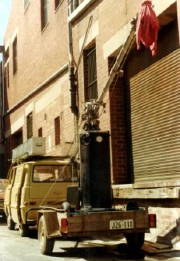
Delivering a Mole-Richardson 103B boom and pram to AAV’s Studio D
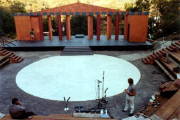
Down by the Yarra...
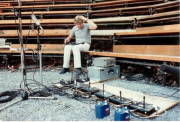
... and figuring frequencies!
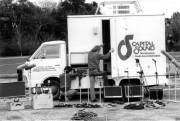
The new and larger Capital Sound Toyota OB van

And its interior – a total of 28 mic channels with a full complement of outboard gear

Murray Tregonning and Peter Evans behind today’s Sofitel in Melbourne with the Capital Sound truck just prior to a sporting awards telecast for SBS
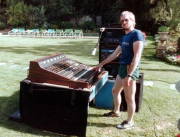
Early adventures in Corporate PA – someone’s mansion somewhere in Toorak for a corporate Christmas party
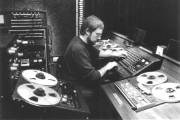
A new control room for Capital Sound’s voice-over studio at 131 Brighton Street Richmond...
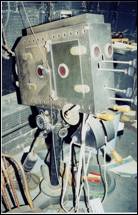
A Brenkert follow spot similar to those used at the Palais – difficult to use, but built like a Mack truck
|
